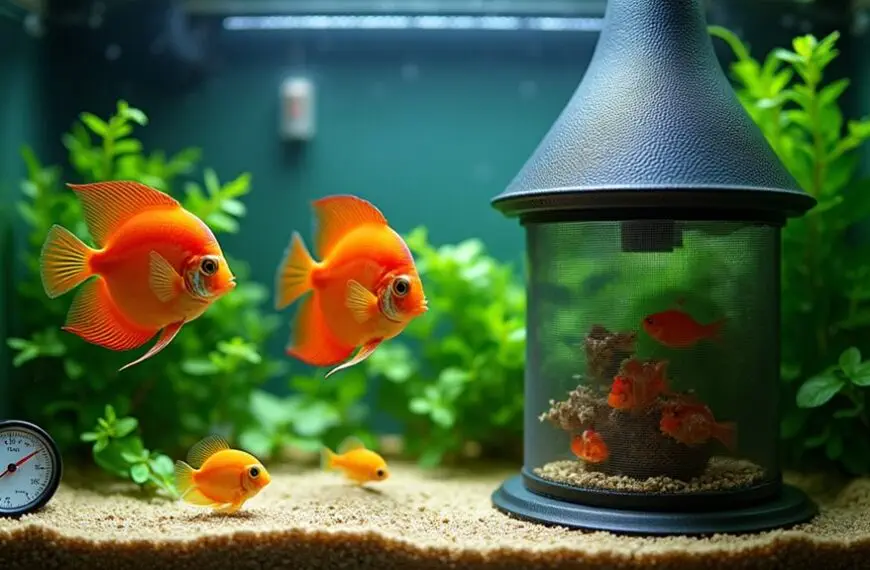Successful tropical fish breeding starts with understanding your species' unique behaviors. You'll need to maintain ideal water parameters that match their natural habitat and set up a dedicated breeding tank with proper filtration and hiding spots. Feed your fish high-quality foods for 2-3 weeks before breeding, and watch for signs like intensified coloration and nest building. Once eggs appear, provide gentle filtration and appropriate food for the fry. These fundamentals will transform your hobby into a rewarding adventure.
Contents
- 1 Understanding Breeding Behaviors Across Different Tropical Fish Species
- 2 Creating Optimal Water Parameters for Successful Spawning
- 3 Essential Equipment and Tank Setup for Breeding
- 4 Conditioning Fish With Proper Nutrition and Care
- 5 Recognizing Signs of Breeding Readiness
- 6 Special Techniques for Difficult-to-Breed Species
- 7 Caring for Eggs and Protecting Young Fry
- 8 Separating and Raising Fry to Adulthood
- 9 Frequently Asked Questions
- 9.1 How Do I Market and Sell My Excess Bred Tropical Fish?
- 9.2 When Is the Best Time of Year to Breed Tropical Fish?
- 9.3 Can Different Tropical Fish Species Crossbreed and Produce Hybrid Offspring?
- 9.4 How Many Generations Can I Breed Before Genetic Issues Appear?
- 9.5 What Licenses or Permits Might I Need for Breeding at Scale?
- 10 Final Thoughts
Understanding Breeding Behaviors Across Different Tropical Fish Species
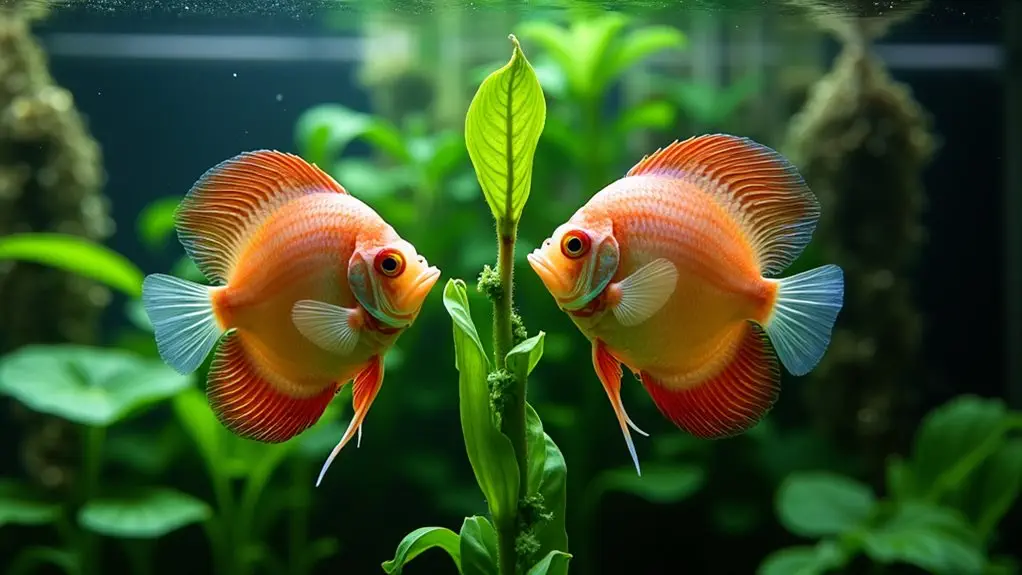
When you decide to breed tropical fish, you'll quickly discover that each species has its own unique courtship dance.
Livebearers like guppies and mollies engage in simple chasing behaviors, while cichlids perform elaborate breeding rituals that include fin displays and territory cleaning.
Bettas create bubble nests at the water's surface before their dramatic mating displays, while angelfish clean flat surfaces to deposit their eggs.
Rainbow fish scatter eggs among plants, and discus fish become protective parents who secrete special mucus to feed their fry.
You'll need patience to recognize these behaviors, as timing is everything.
Watch for color intensification, territorial behavior, and pair bonding—these are reliable signs that your fish are ready to spawn.
The reward of witnessing these natural behaviors is truly worth the wait!
Creating Optimal Water Parameters for Successful Spawning
Once you've identified your fish's specific breeding behaviors, the next step involves setting up the perfect water chemistry to encourage spawning.
Getting the water parameters right can make all the difference between success and disappointment in your breeding efforts.
Start by testing and adjusting pH levels to match your species' natural habitat. Some fish need acidic conditions (below 7.0), while others thrive in alkaline waters.
Water hardness is equally important—soft water species won't breed in hard water, and vice versa.
Don't forget that temperature fluctuations can trigger spawning in many species!
Maintaining consistent temperatures in the ideal range is also crucial for promoting healthy breeding behaviors.
You'll want to invest in reliable testing kits and perhaps a TDS (total dissolved solids) meter.
Essential Equipment and Tank Setup for Breeding
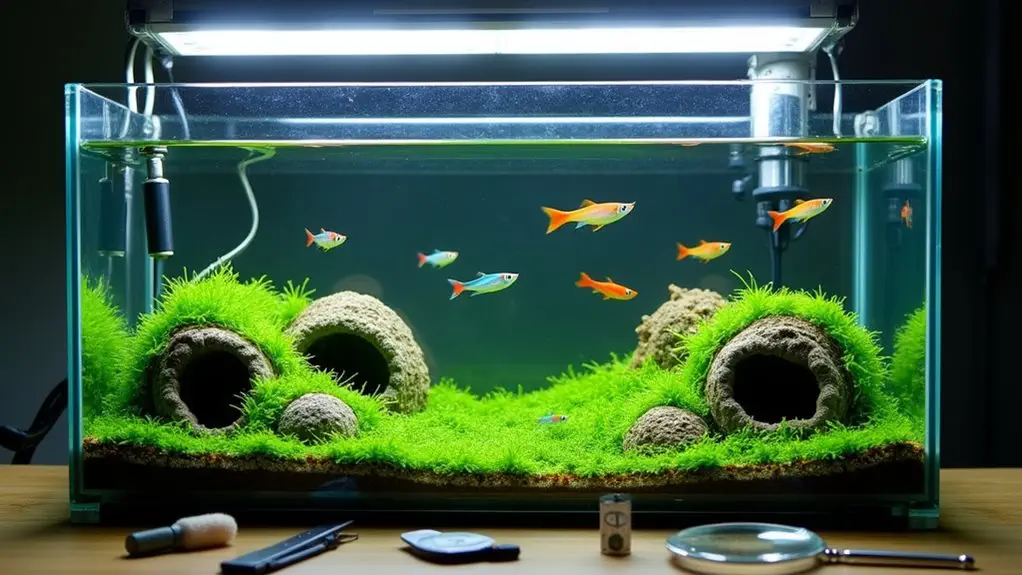
Successful tropical fish breeding depends heavily on creating the perfect environment with the right equipment.
You'll need a dedicated breeding tank with appropriate tank volume for your specific species—generally 10-20 gallons works well for most beginners. Remember, smaller tanks make it easier to monitor fry but require more frequent water changes.
A gentle, sponge-based filtration system is essential, as it prevents tiny fry from being sucked into standard filters.
Don't forget to include plenty of hiding spots like fine-leaved plants or breeding mops where eggs can be deposited safely.
You'll also want a reliable heater with a thermostat to maintain consistent temperatures—fluctuations can halt breeding behaviors in their tracks!
Establishing a stable nitrogen cycle in the tank before introducing breeding pairs will greatly enhance the health of both parents and fry.
Setting up a breeding tank isn't complicated, but attention to these details will dramatically improve your chances of success.
Conditioning Fish With Proper Nutrition and Care
Before your tropical fish will readily spawn, proper conditioning through nutrition and dedicated care is absolutely essential.
You'll need to boost your breeding stock's health with a varied diet that includes live foods like brine shrimp, daphnia, and bloodworms, which stimulate spawning behavior naturally.
Your fish's health directly impacts breeding success, so watch for vibrant colors and active swimming—these are signs your conditioning is working.
Healthy fish breed better—look for bright colors and energetic movement as proof your preparation is effective.
Don't rush this process! Most species need 2-3 weeks of specialized feeding before they're ready to spawn.
Remember to maintain pristine water conditions during conditioning, as this mimics the natural seasonal changes that trigger breeding. Regular monitoring of water parameters ensures that conditions remain optimal for breeding.
You'll know you're on the right track when females begin to round out with eggs and males display their brightest colors.
Recognizing Signs of Breeding Readiness
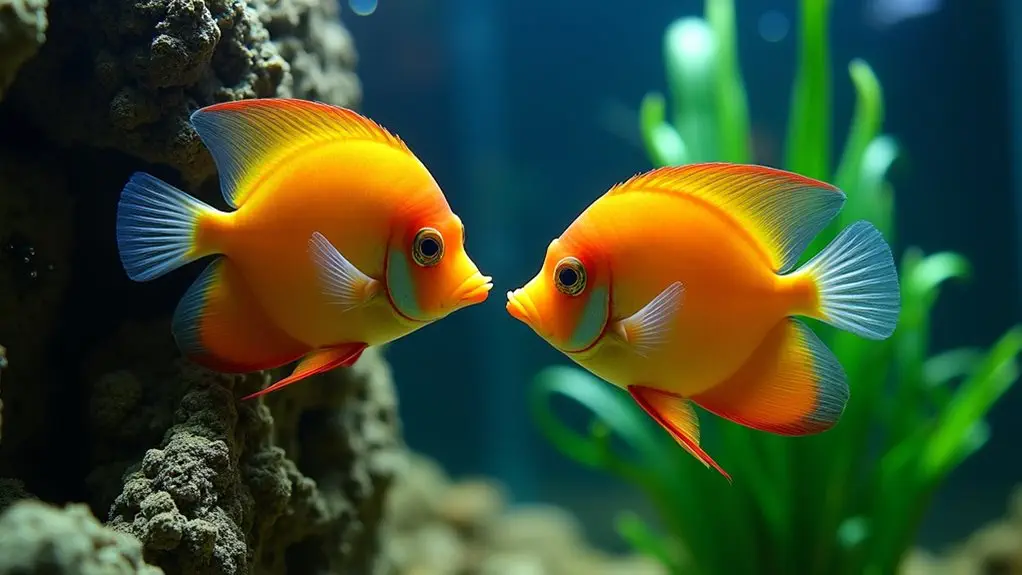
After careful conditioning, you'll need to watch for telltale signs that your tropical fish are ready to spawn. The most obvious breeding signals include intensified coloration, with males often displaying their brightest hues to attract females.
You'll also notice increased activity, as fish dart around the tank with newfound energy.
Gender identification becomes vital at this stage. Look for physical differences: males typically show more pointed fins and slimmer bodies, while females develop rounder, plumper bellies as they fill with eggs.
In many species, you'll spot males building bubble nests or clearing territories—they're fundamentally setting up nurseries! Females might appear restless, swimming alongside males or showing submission behaviors.
Don't miss these signs—timing is everything in tropical fish breeding! When you see these behaviors, it's your cue to prepare the breeding tank.
Special Techniques for Difficult-to-Breed Species
You'll find that some tropical fish species need special attention to coax them into breeding.
Try conditioning your finicky breeders with protein-rich live foods like brine shrimp or daphnia, which often triggers their reproductive instincts.
You can also manipulate water parameters to match their natural spawning conditions, then use specific triggers like changing water temperature, simulating rainfall, or adjusting light cycles to convince even the most stubborn species it's time to reproduce.
Conditioning With Live Foods
When dealing with stubbornly reluctant breeders, live foods can make all the difference between frustration and success.
Many tropical fish won't spawn unless they're in prime condition, and nothing conditions fish better than a varied diet of live foods. The nutritional benefits of live foods trigger breeding behaviors that processed foods simply can't match.
You'll find that live food availability isn't as challenging as you might think—many can be cultured at home with minimal equipment.
- Microworms provide perfect first foods for tiny fry
- Brine shrimp stimulate breeding in most egg-layers
- Daphnia work wonders for conditioning livebearers
- Blackworms trigger spawning in many cichlid species
- Fruit flies (wingless) are excellent for surface feeders
Try rotating these options to provide complete nutrition and watch your fish respond with vibrant colors and spawning behavior.
Species-Specific Water Parameters
Some of the most rewarding breeding successes come from mastering the precise water parameters that mimic a species' natural habitat.
You'll need to research specific pH levels, temperature ranges, and water hardness requirements for your fish. Many species won't even consider spawning unless these conditions are perfect!
Setting up dedicated breeding tanks with appropriate substrate types can make all the difference.
Don't forget to install reliable filtration systems that maintain water quality without creating excessive current. Regular water changes are essential, and sometimes chemical additives help achieve the exact parameters you need.
Tank size matters too—some fish need spacious quarters to trigger breeding behaviors, while others prefer cozy setups.
Finally, adjusting lighting conditions can stimulate spawning in many species. It's like creating a romantic mood for your finned friends! Maintaining optimal pH ranges helps ensure that breeding conditions remain favorable throughout the process.
Spawning Trigger Techniques
Beyond perfecting water parameters, even the most stubborn species can be coaxed into breeding with specialized trigger techniques. Understanding your fish's natural spawning rituals can make all the difference when conventional methods fail.
Environmental cues that mimic seasonal changes often trigger breeding behaviors in tropical species that seem impossible to breed in captivity.
- Simulate rainfall by slowly dripping cooler water into the tank, imitating monsoon seasons
- Adjust lighting cycles to mimic seasonal changes (shorter days for some species, longer for others)
- Introduce spawning mops or specialized breeding media that match natural habitats
- Try the "conditioning tank" method, separating males and females for 1-2 weeks before reintroduction
- Add tannins through Indian almond leaves or peat to stimulate spawning in blackwater species
You'll be amazed how these natural triggers can transform reluctant breeders into prolific parents!
Caring for Eggs and Protecting Young Fry
Once your fish have successfully spawned, your real work as a breeder begins. Proper egg care is essential during these first fragile days. Remove any eggs that turn white or fuzzy, as they're likely infertile or infected with fungus.
Success in breeding is just the beginning — the true art lies in those critical first days of egg care.
For many species, you'll want to separate parents from the eggs to prevent them from snacking on their own offspring!
Fry protection becomes your top priority once they hatch. These tiny newcomers need pristine water conditions and appropriately sized food—microworms, infusoria, or commercial fry food work wonderfully.
Create hiding spots using dense plants or breeding boxes if you're keeping them in a community tank. Remember, your filter intake can become a deadly vacuum for curious fry, so cover it with a sponge or fine mesh.
You'll be amazed watching these tiny specks grow into beautiful adult fish!
Separating and Raising Fry to Adulthood
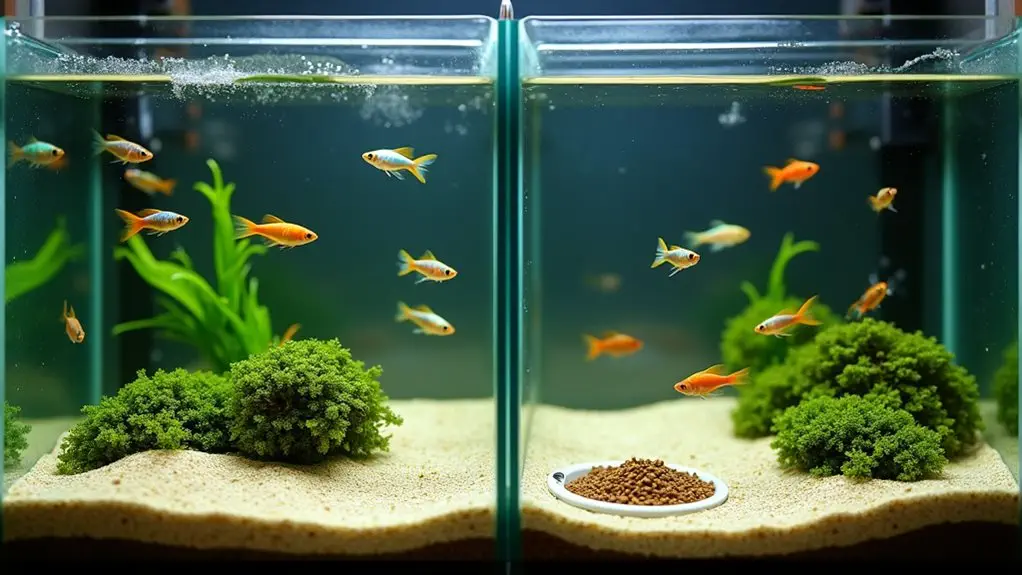
After your fry have survived their first few days, you'll need to contemplate separate housing for these delicate youngsters.
Fry separation is vital for their development, as adult fish often see these tiny swimmers as snacks rather than offspring. You'll witness amazing growth milestones as they transform from nearly transparent specks to miniature versions of their parents.
- Set up a dedicated "grow-out" tank with a sponge filter to prevent accidents
- Feed your fry 3-5 times daily with specialized foods like infusoria or powdered fry food
- Monitor water parameters closely—fry are extremely sensitive to ammonia and nitrites
- Perform small, frequent water changes (10-15% every other day) using aged water
- Sort fry by size every few weeks to prevent bullying and guarantee even growth rates
Frequently Asked Questions
How Do I Market and Sell My Excess Bred Tropical Fish?
You'll maximize profits by posting on aquarium forums, joining fish marketing social media groups, and reaching out to local pet stores. Don't forget to create attractive photos for effective selling strategies online.
When Is the Best Time of Year to Breed Tropical Fish?
While nature follows seasons, your home aquarium defies time. You'll find breeding success year-round if you control temperature fluctuations. Most tropical fish breed best during spring and summer when warmer temperatures naturally trigger their reproductive instincts.
Can Different Tropical Fish Species Crossbreed and Produce Hybrid Offspring?
Yes, certain tropical fish can crossbreed if they're closely related and have species compatibility. You'll find that some hybrids display hybrid vigor, while others may be sterile or have health issues. Always research before attempting crossbreeding.
How Many Generations Can I Breed Before Genetic Issues Appear?
Like sailors charting treacherous waters, you'll face inbreeding concerns after 3-5 generations. You'll need to introduce new bloodlines regularly to maintain genetic diversity and prevent deformities in your fish family tree.
What Licenses or Permits Might I Need for Breeding at Scale?
You'll need to check local breeding regulations for commercial licenses. Licensing requirements vary by location, species, and scale. Contact your fish and wildlife department to understand what permits apply to your operation.
Final Thoughts
You've now joined the elite club of aquatic matchmakers—congratulations! While your friends waste time on dating apps, you're orchestrating fish romance with the precision of a soap opera director. Remember, you're not just breeding fish; you're creating underwater dynasties. So maintain those water parameters, keep your fish well-fed, and maybe invest in tiny underwater violins for ambiance. Your finned friends will thank you with hundreds of offspring you'll soon struggle to rehome!



